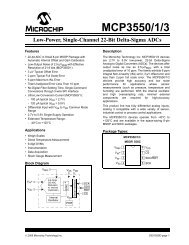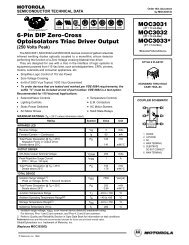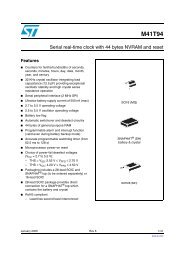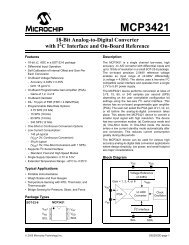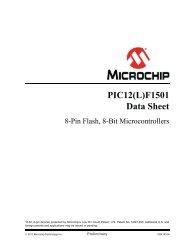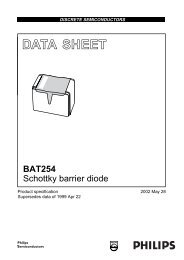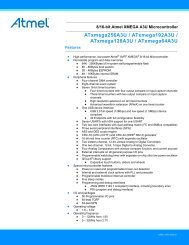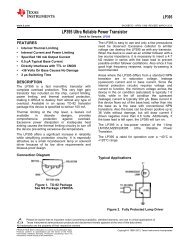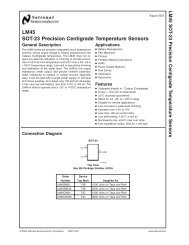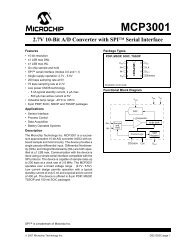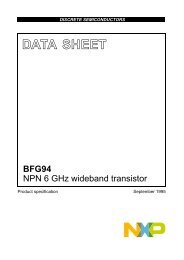DP83848C PHYTER Comm Temp Single Port ... - Texas Instruments
DP83848C PHYTER Comm Temp Single Port ... - Texas Instruments
DP83848C PHYTER Comm Temp Single Port ... - Texas Instruments
You also want an ePaper? Increase the reach of your titles
YUMPU automatically turns print PDFs into web optimized ePapers that Google loves.
<strong>DP83848C</strong>4.2.7 DescramblerA serial descrambler is used to de-scramble the receivedNRZ data. The descrambler has to generate an identicaldata scrambling sequence (N) in order to recover the originalunscrambled data (UD) from the scrambled data (SD)as represented in the equations:SD=( UD ⊕ N)UD=( SD ⊕ N)Synchronization of the descrambler to the original scramblingsequence (N) is achieved based on the knowledgethat the incoming scrambled data stream consists ofscrambled IDLE data. After the descrambler has recognized12 consecutive IDLE code-groups, where anunscrambled IDLE code-group in 5B NRZ is equal to fiveconsecutive ones (11111), it will synchronize to the receivedata stream and generate unscrambled data in the form ofunaligned 5B code-groups.In order to maintain synchronization, the descrambler mustcontinuously monitor the validity of the unscrambled datathat it generates. To ensure this, a line state monitor and ahold timer are used to constantly monitor the synchronizationstatus. Upon synchronization of the descrambler thehold timer starts a 722 µs countdown. Upon detection ofsufficient IDLE code-groups (58 bit times) within the 722 µsperiod, the hold timer will reset and begin a new countdown.This monitoring operation will continue indefinitelygiven a properly operating network connection with goodsignal integrity. If the line state monitor does not recognizesufficient unscrambled IDLE code-groups within the 722 µsperiod, the entire descrambler will be forced out of the currentstate of synchronization and reset in order to reacquiresynchronization.4.2.10 100BASE-TX Link Integrity MonitorThe 100 Base TX Link monitor ensures that a valid and stablelink is established before enabling both the Transmitand Receive PCS layer.Signal detect must be valid for 395us to allow the link monitorto enter the 'Link Up' state, and enable the transmit andreceive functions.4.2.11 Bad SSD DetectionA Bad Start of Stream Delimiter (Bad SSD) is any transitionfrom consecutive idle code-groups to non-idle code-groupswhich is not prefixed by the code-group pair /J/K.If this condition is detected, the <strong>DP83848C</strong> will assertRX_ER and present RXD[3:0] = 1110 to the MII for thecycles that correspond to received 5B code-groups until atleast two IDLE code groups are detected. In addition, theFalse Carrier Sense Counter register (FCSCR) will beincremented by one.Once at least two IDLE code groups are detected, RX_ERand CRS become de-asserted.4.3 10BASE-T TRANSCEIVER MODULEThe 10BASE-T Transceiver Module is IEEE 802.3 compliant.It includes the receiver, transmitter, collision, heartbeat,loopback, jabber, and link integrity functions, asdefined in the standard. An external filter is not required onthe 10BASE-T interface since this is integrated inside the<strong>DP83848C</strong>. This section focuses on the general 10BASE-Tsystem level operation.4.2.8 Code-group AlignmentThe code-group alignment module operates on unaligned5-bit data from the descrambler (or, if the descrambler isbypassed, directly from the NRZI/NRZ decoder) and convertsit into 5B code-group data (5 bits). Code-group alignmentoccurs after the J/K code-group pair is detected.Once the J/K code-group pair (11000 10001) is detected,subsequent data is aligned on a fixed boundary.4.2.9 4B/5B DecoderThe code-group decoder functions as a look up table thattranslates incoming 5B code-groups into 4B nibbles. Thecode-group decoder first detects the J/K code-group pairpreceded by IDLE code-groups and replaces the J/K withMAC preamble. Specifically, the J/K 10-bit code-group pairis replaced by the nibble pair (0101 0101). All subsequent5B code-groups are converted to the corresponding 4Bnibbles for the duration of the entire packet. This conversionceases upon the detection of the T/R code-group pairdenoting the End of Stream Delimiter (ESD) or with thereception of a minimum of two IDLE code-groups.4.3.1 Operational ModesThe <strong>DP83848C</strong> has two basic 10BASE-T operationalmodes:— Half Duplex mode— Full Duplex modeHalf Duplex ModeIn Half Duplex mode the <strong>DP83848C</strong> functions as a standardIEEE 802.3 10BASE-T transceiver supporting theCSMA/CD protocol.Full Duplex ModeIn Full Duplex mode the <strong>DP83848C</strong> is capable of simultaneouslytransmitting and receiving without asserting thecollision signal. The <strong>DP83848C</strong>'s 10 Mb/s ENDEC isdesigned to encode and decode simultaneously.www.national.com 30



